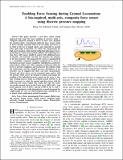Enabling Force Sensing During Ground Locomotion: A Bio-Inspired, Multi-Axis, Composite Force Sensor Using Discrete Pressure Mapping
Author(s)
Chuah, Meng Yee; Kim, Sangbae
DownloadMain article (4.668Mb)
OPEN_ACCESS_POLICY
Open Access Policy
Creative Commons Attribution-Noncommercial-Share Alike
Terms of use
Metadata
Show full item recordAbstract
This paper presents a new force sensor design approach that maps the local sampling of pressure inside a composite polymeric footpad to forces in three axes, designed for running robots. Conventional multiaxis force sensors made of heavy metallic materials tend to be too bulky and heavy to be fitted in the feet of legged robots, and vulnerable to inertial noise upon high acceleration. To satisfy the requirements for high speed running, which include mitigating high impact forces, protecting the sensors from ground collision, and enhancing traction, these stiff sensors should be paired with additional layers of durable, soft materials; but this also degrades the integrity of the foot structure. The proposed foot sensor is manufactured as a monolithic, composite structure composed of an array of barometric pressure sensors completely embedded in a protective polyurethane rubber layer. This composite architecture allows the layers to provide compliance and traction for foot collision while the deformation and the sampled pressure distribution of the structure can be mapped into three axis force measurement. Normal and shear forces can be measured upon contact with the ground, which causes the footpad to deform and change the readings of the individual pressure sensors in the array. A one-time training process using an artificial neural network is all that is necessary to relate the normal and shear forces with the multiaxis foot sensor output. The results show that the sensor can predict normal forces in the Z-axis up to 300 N with a root mean squared error of 0.66% and up to 80 N in the X- and Y-axis. The experiment results demonstrates a proof-of-concept for a lightweight, low cost, yet robust footpad sensor suitable for use in legged robots undergoing ground locomotion.
Date issued
2014-03Department
Massachusetts Institute of Technology. Department of Mechanical EngineeringJournal
IEEE Sensors Journal
Publisher
Institute of Electrical and Electronics Engineers (IEEE)
Citation
Chuah, Meng Yee, and Sangbae Kim. “Enabling Force Sensing During Ground Locomotion: A Bio-Inspired, Multi-Axis, Composite Force Sensor Using Discrete Pressure Mapping.” IEEE Sensors J. 14, no. 5 (May 2014): 1693–1703.
Version: Author's final manuscript
ISSN
1530-437X
1558-1748